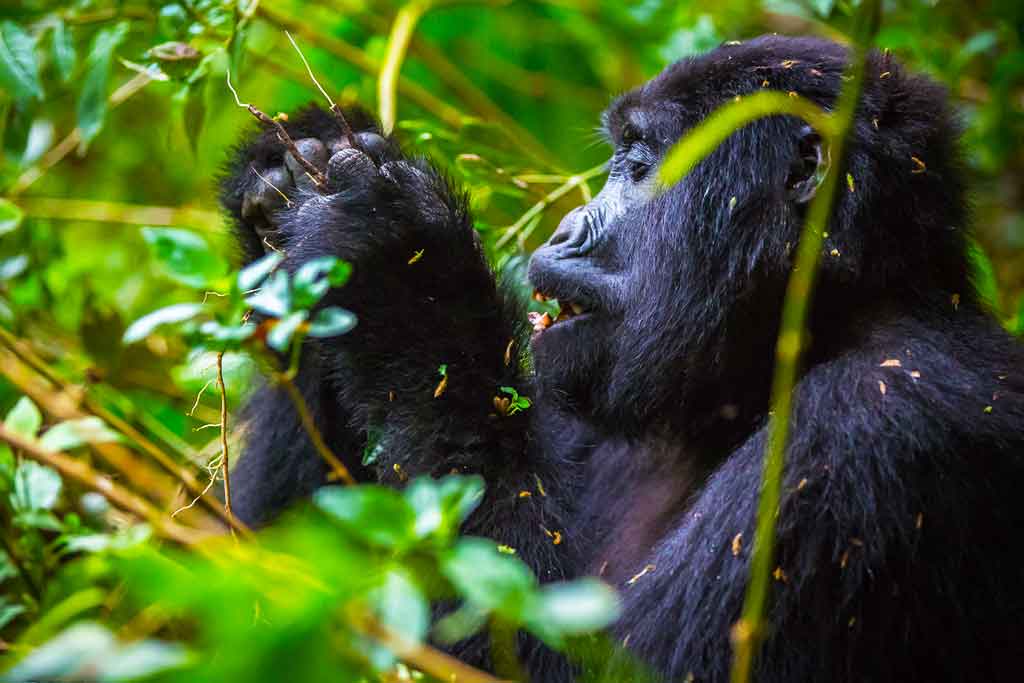While studying about food & foraging of mountain gorillas, it is important to know that a gorilla’s day is synchronized, divided between rest periods and travel or feeding periods. Diets differ between and within species, but mountain gorillas mostly eat foliage, such as leaves, stems, pith, and shoots, while fruit makes up a very small part of their diets.

Food for mountain gorillas is widely distributed and neither individuals nor groups have to compete with one another. Their home ranges average 3–15 sqkm (1.16–5.79 sqmi), and their movements range around 500 m (0.31 mi) or less on an average day. Despite eating a few species in each habitat, mountain gorillas have flexible diets and can live in a variety of habitats.
What gorillas eat depends on what their habitat provides and on the time of the year. Mountain gorillas mainly feed on green plant parts, whereas lowland gorillas eat a lot of fruit. However, in the dry season only a few juicy fruits are available and so the animals have to eat more seeds and tree bark instead. Usually, fruits grow on trees; gorillas of all ages climb these trees to harvest them. Although western gorillas eat a higher percentage of fruit than of leaves, stems, pith and shoots, they still eat markedly less fruit than chimpanzees and orangutans.
What is the food composition for mountain gorillas? – Food & foraging
The food range of the western gorillas is very broad: they eat about 200 plant species. They particularly like plants belonging to the ginger and arrowroot families. In contrast, the mountain gorillas in the Virunga Volcanoes eat only 38 different plant species, mainly gallium, thistles, celery and nettles.
For western lowland gorillas, they can consume almost all of the plant species available in its sight. According to experts, they consume about 67% fruit, 17% is other plant materials such as leaves and stems and the remaining 3% are insects such as termites, ants, and caterpillars.
As we have said earlier, gorillas are herbivorous, so they can survive eating plant materials such as leaves, stems, shoots, roots, flowers and fruits. However, these materials are of low nutrient contents so they are obliged to eat a vast quantity of plants every day to sustain their body. For example, an adult gorilla consumes more than 40 pounds of plant materials per day, which is equivalent to 18 kilograms. Because they consume vegetation which is watery (50% is water), gorillas seldom drink water directly from a source. Gorillas also get water from dew drops collected on leaf surfaces.
Food & foraging for lowland mountain gorillas
Eastern lowland gorillas, on the other hand, are quite specific when it comes to the plants that they eat. Experts have identified 104 species of plants that they consume in parts and only 3 kinds of fruit.
The diet of mountain gorillas consists of 86% plant materials such as leaves, stems, and shoots. They also eat roots and flowers which form 7% and 2% of their diet, respectively.
An adult male Grauer’s gorilla is estimated to eat about 30 kg of plants every day, and a female about 18 kg. To be able to process these masses of plant material, gorillas have very strong chewing muscles. Their teeth are much like human teeth, except for the very long, pointed canines of adult gorilla males. The males do not use those for feeding but for fighting against competing males.
Apart from plants, they ingest soil occasionally. Perhaps this soil contains minerals that are missing in their plants, or the minerals neutralize poisonous substances in their food.
Although gorillas don’t kill big animals, they regularly eat small insects. However, this constitutes far less than 0.1% of their diet, but in chimpanzees, up to 6% of their food may be animal matter.
There are important differences in the nutritional composition of gorillas’ and chimpanzees’ termite prey species. Gorillas select termites high in iron and ash with possible anti-diarrheal characteristics. Termite eating in western lowland gorillas might therefore be a high quality alternative for geophagy.
How do gorillas get their food?
They use their incredible strength in tearing apart vegetation. Gorillas can use their incredible strength to break apart vegetation. An adult male for example can shred apart a whole banana tree to get to the interior tender pith.
They usually get their food in a manner that the plant will easily recover from the foraging damage.
Gorillas are very selective foragers, so they usually only eat parts of vegetation. For example they may eat only the leaves, pith, stalk, or roots of a particular plant. They use their agile lips and hand dexterity to manipulate the vegetation for the particular portion they want to consume.
Gorillas do not overexploit an area for food. They crop the vegetation in a manner that allows for quick replenishment to occur.
Gorillas have been recorded using the hair on the back of their hands to absorb water and then sucking it.
Do gorillas eat meat?
We know that gorillas are herbivores and their diet consist mainly of vegetation. So, where do gorillas get protein? Do they eat meat? The answer is NO, gorillas don’t eat meat. But they satisfy the need to eat protein foods by eating bugs like ants, termites, and caterpillars. Insects are a good source of protein for gorillas.
